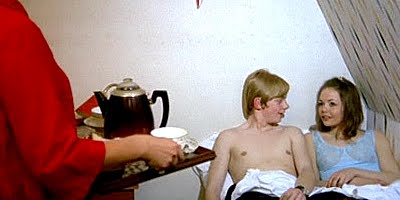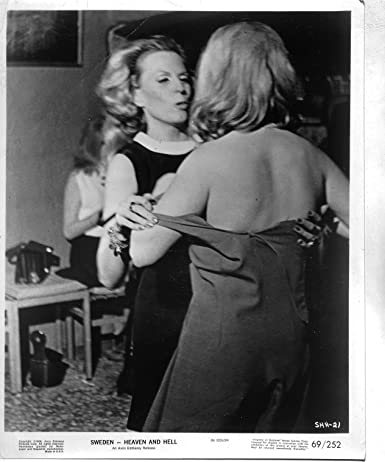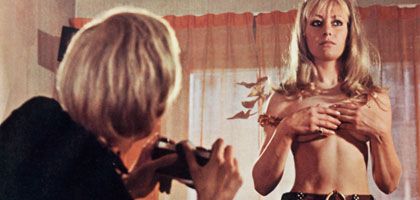 Between 1967 and 1974 Sweden emerged as the most progressive and liberal nation in the world due to a government that supported a wide variety of social and political interests such as women’s rights, anti-war advocacy and the environmental movement along with a relaxed attitude about sex. Films like Mac Ahlberg’s I, a Woman (1965), Vilgot Sjoman’s I Am Curious (Yellow) from 1967, and Joseph Sarno’s Inga (1968) also helped confirm Sweden’s image as an epicenter of sexual freedom so it was inevitable that such a situation would inspire a moralistic backlash. What no one expected was that it would come from Italy in the form of a Mondo Cane-like documentary directed by Luigi Scattini entitled Sweden: Heaven and Hell (1968).
Between 1967 and 1974 Sweden emerged as the most progressive and liberal nation in the world due to a government that supported a wide variety of social and political interests such as women’s rights, anti-war advocacy and the environmental movement along with a relaxed attitude about sex. Films like Mac Ahlberg’s I, a Woman (1965), Vilgot Sjoman’s I Am Curious (Yellow) from 1967, and Joseph Sarno’s Inga (1968) also helped confirm Sweden’s image as an epicenter of sexual freedom so it was inevitable that such a situation would inspire a moralistic backlash. What no one expected was that it would come from Italy in the form of a Mondo Cane-like documentary directed by Luigi Scattini entitled Sweden: Heaven and Hell (1968).

The song “Mah-na Mah-na” was introduced to most U.S. viewers via The Muppets television show and not the shockumentary Sweden: Heaven and Hell (1968).
Even if the movie is not well known today, almost everyone is familiar with the song “Mah-Na Mah-Na” which is featured in the film score by Piero Umiliami. The tune has gone on to achieve immortality thanks to its introduction on The Muppets television show in 1977 and it is an incessantly upbeat, playful pop tune with a kazoo solo and vocals by Alessandro Alessandroni that will either delight you or lodge in your brain and drive you crazy.
If you were to listen to Umiliami’s score to Sweden: Heaven and Hell with its addictive mix of samba, lounge, easy listening jazz and Euro-pop influences, you’d never guess it was the soundtrack to an X-rated sexploitation film that mostly played American grindhouses and drive-ins during its original release.

The opening credit sequence for Sweden: Heaven and Hell features bizarre choreography of nubile women on hop-a-loops.
But Umiliami’s soundtrack is only one aspect of Sweden: Heaven and Hell that makes it an eccentric, stand-alone entry in the field of shockumentaries. Scattini’s film consists of mostly staged scenes and re-enactments with non-professional Swedish extras even though it poses as a documentary. Added to this is voice-over narration by Edmund Purdom (Enrico Maria Salerno provides the v/o in the Italian version) that is so leering, judgmental and sarcastic in its insinuations that it becomes unintentionally hilarious. And once you realize that the film’s editorial tone has been shaped by the Italian filmmaking team of director/screenwriter/editor Scattini, cinematographer Claudio Racca and producer Mario Borghi, it has more to say about Scattini and company’s attitudes about Swedish society than the Swedes themselves. You have to wonder if they were motivated by jealousy and envy.

Sex education, abortion, premarital sex, interracial dating and other topics are explored in the Mondo Cane-like shockumentary, Sweden: Heaven and Hell (1969).
Also, most mondo movies are international in scope, focusing on bizarre rituals and customs from around the world. The fact that Scattini’s film concentrates solely on one culture or country is unusual. Sweden: Heaven and Hell is also completely free of scenes of animal cruelty and death, which is one of the more repellent aspects of the genre.

Newfangled sleepover: Mom serves breakfast in bed to her daughter and overnight guest in Sweden: Heaven and Hell (1968).
So where to begin on describing this strange cinematic animal that is more fiction than fact? On the surface Sweden: Heaven and Hell looks like a professionally shot travelogue utilizing the sort of non-actors you would see in classroom educational films. By today’s standards, very little of the footage is controversial or explicit. There is some mild female nudity but most of the more exploitive scenes are patently ridiculous such as a bunch of alcoholic bums eating shoe polish on bread (WHAT?), a suicidal teenage girl jumping to her death, a drunken Swede who froze to death in the snow and the staged rape of a girl by a motorcycle gang (the victim is played by Marie Liljedahl, the Swedish exploitation starlet of Inga, Three-Cornered Bed and Jess Franco’s Eugenie).

CIRCA 1968: A view from of the documentary movie “Sweden: Heaven and Hell” circa 1968. (Photo by Michael Ochs Archives/Getty Images)
What transforms this rather tame, semi-naughty material into something more salacious and condemnatory is the film’s commentary which employs a bait-and-switch tactic for the entire running time. A perfect example is a sequence depicting the annual Yuletide celebration of Santa Lucia when angelic-looking girls clan in white and wearing lights in their hair go door to door singing hymns. Narrator Edmund Purdom, pondering the identity of the girls, wonders, “In real life, is she a nurse? Does she teach in kindergarten? Is she the daughter of a Protestant pastor, one of those tall bony men in Bergman films?…Or are these angels the kind who change their bed partners every night in the sexiest Swedish films? Perhaps we aren’t so close to Heaven after all?”

The heavenly maidens of the Santa Lucia celebration are given questionable identities by the sleazy narrator of Sweden: Heaven and Hell (1968).
Another vignette shows a popular rite of passage for teenagers – hedonistic barge cruises that travel around the islands near Stockholm while girls and boys drink, neck and switch partners several times during the trip. The narrator tells us that often the boat excursions are an excuse for teenage girls to lose their virginity and the sequence ends with a close-up of a girl’s blissful face. Then comes the voice-over kicker: “Only her eyes betray her happiness and reveal the shock of her first sexual experience. She thinks she is happy.”

Pleasure barge tours are popular in Stockholm with teenagers who want to lose their virginity or switch partners a lot during a single night in Sweden: Heaven and Hell (1968).
Talk about imposing an alternative reality on what appears to be the opposite of what Purdom is saying! The entire faux documentary proceeds in this manner and I think Sweden: Heaven and Hell serves as a brilliant masterclass in how to take a film and create a completely false narrative for it using voice-over talent that applies an attitude-leaden critique to the subject matter. This is how you create the most effective and subversive kind of fake news story and Luigi Scattini is an expert of the form.

A private club for lesbians is one of several staged sequences in the shockumentary Sweden: Heaven and Hell (1968).
But does Scattini’s film qualify as anti-Swedish propaganda? You could certainly argue the point although the film actually functions as an equal opportunity offender for everyone. Age, race, religion, gender, social class – everything is fair game. A sequence on senior citizens shows some drab, institutional-looking retirement communities which Purdom refers to as “the elephant’s graveyard.” We get a glimpse of a private lesbian club where the attendees are labeled “human wreckage.” City of Stockholm employees like meter maids are shown dispensing parking tickets and then revealed as moonlighters who earn extra money posing as nude models! Most telling of all is an episode where Italian male/Latin lover types – once popular with Swedish women – try to reinvent themselves as hippies but are rejected by singles bars’ females who prefer black men. Why? Because they make better, more sensitive lovers.

She might be a meter maid or schoolteacher by day but after hours she moonlights as a nude model for hire in Sweden: Heaven and Hell (1968).
In addition, Umiliani’s “Mah-na Mah-na” is highlighted in probably the most frivolous and inane segment in Sweden: Heaven and Hell: a group of young women strip down for a sauna and then run out into the snow before jumping into an ice hole in a frozen lake for a quick dip. Yet, despite an emphasis on sex and sexual matters for most of the film’s duration, Scattini chooses to end his documentary on a somber note. The movie culminates in a vignette in which students are being trained to live underground in a bunker-like existence in the event of a nuclear war.  For a total WTF experience, it is hard to top Sweden: Heaven and Hell and it is consistently entertaining because it is so absurd and perverse. It is also slightly chilling in the way it prefigures today’s climate of fake news which has become the new normal. In an interview for Mark Goodall’s Sweet & Savage: The World Through the Shockumentary Film Lens, novelist/short story writer J.G. Ballard (Crash, Empire of the Sun) reveals his fascination with the entire genre: “For me, the Mondo Cane films were an important key to what was going on in the media landscape of the 1960s, especially post the JFK assassination. Nothing was true, and nothing was untrue….there are many resonances today as in the Bush/Blair war in Iraq – complete confusion of the simulated, the real and the unreal, and the acceptance of this by the electorate. Reality is constantly redefining itself, and the electorate/audience seems to like this…There’s a strong sense today that we prefer a partly fictionalized reality onto which we can map our own dreams and obsessions. The Mondo Cane films were among the first attempts to provide the collusive fictions that constitute reality today.”
For a total WTF experience, it is hard to top Sweden: Heaven and Hell and it is consistently entertaining because it is so absurd and perverse. It is also slightly chilling in the way it prefigures today’s climate of fake news which has become the new normal. In an interview for Mark Goodall’s Sweet & Savage: The World Through the Shockumentary Film Lens, novelist/short story writer J.G. Ballard (Crash, Empire of the Sun) reveals his fascination with the entire genre: “For me, the Mondo Cane films were an important key to what was going on in the media landscape of the 1960s, especially post the JFK assassination. Nothing was true, and nothing was untrue….there are many resonances today as in the Bush/Blair war in Iraq – complete confusion of the simulated, the real and the unreal, and the acceptance of this by the electorate. Reality is constantly redefining itself, and the electorate/audience seems to like this…There’s a strong sense today that we prefer a partly fictionalized reality onto which we can map our own dreams and obsessions. The Mondo Cane films were among the first attempts to provide the collusive fictions that constitute reality today.”

The famous spa/ice hole swimming scene from Sweden: Heaven and Hell (1968), directed by Luigi Scattini.
Sweden: Heaven and Hell never had a theatrical release in Sweden. When Scattini was making the film, he promised the Swedish participants and actors he hired that no one in their country would ever see it. Unfortunately for them, Scattini’s documentary was broadcast on Swedish television on December 28, 1971 and it stirred up considerable controversy. One of the outraged responses came from Asta Gustavsson, who had been hired by Scattini to stage some scenes with actors in a so-called sex club. Imagine her surprise when she saw herself identified as the madam of a whorehouse in the completed film! (An excellent article on the film’s premiere on Swedish TV by Lars Erik Holmquist can be found in issue 145 of Video Watchdog from editor/publisher Tim Lucas.).  As you can imagine, Luigi Scattini does not have the most distinguished track record as a director. He has dabbled in several genres including comedy (War Italian Style, 1965, with Italian comics Franco Franchi & Ciccio Ingrassia and guest star Buster Keaton); spy thriller (Rings Around the World, 1966); action-adventure (The Glass Sphinx, 1967, starring Robert Taylor in one of his final films); erotic melodrama (The Body, 1974, featuring Carroll Baker). Mondo-clone movies, however, seem to be his calling card starting with his directorial debut Sexy Magico (1963), which he followed with Primitive Love (1964), a bizarre hybrid comedy/Mondo movie with Jayne Mansfield exploring mating rituals of the world. Sweden: Heaven and Hell is probably his masterpiece but until some film scholar can weigh in on his other entries – Witchcraft ’70 (featuring another fantastic Piero Umiliani score) and Questo Sporco Mondo Veraviglioso (1973), who can say for sure?
As you can imagine, Luigi Scattini does not have the most distinguished track record as a director. He has dabbled in several genres including comedy (War Italian Style, 1965, with Italian comics Franco Franchi & Ciccio Ingrassia and guest star Buster Keaton); spy thriller (Rings Around the World, 1966); action-adventure (The Glass Sphinx, 1967, starring Robert Taylor in one of his final films); erotic melodrama (The Body, 1974, featuring Carroll Baker). Mondo-clone movies, however, seem to be his calling card starting with his directorial debut Sexy Magico (1963), which he followed with Primitive Love (1964), a bizarre hybrid comedy/Mondo movie with Jayne Mansfield exploring mating rituals of the world. Sweden: Heaven and Hell is probably his masterpiece but until some film scholar can weigh in on his other entries – Witchcraft ’70 (featuring another fantastic Piero Umiliani score) and Questo Sporco Mondo Veraviglioso (1973), who can say for sure?  Sweden: Heaven and Hell has never had an official authorized release on DVD or Blu-Ray in the U.S. though you can find copies of it for sale from various sources on the internet. European Trash Cinema offers a decent DVD-R of the English language version. You can also still purchase the excellent Piero Umiliani soundtrack on vinyl, CD or MP3 from various sellers.
Sweden: Heaven and Hell has never had an official authorized release on DVD or Blu-Ray in the U.S. though you can find copies of it for sale from various sources on the internet. European Trash Cinema offers a decent DVD-R of the English language version. You can also still purchase the excellent Piero Umiliani soundtrack on vinyl, CD or MP3 from various sellers.  Other websites of interest:
Other websites of interest:
http://videowatchdog.blogspot.com/2008/06/cincinnati-heaven-and-hell.html
https://peoplepill.com/people/luigi-scattini/
https://trailersfromhell.com/joe-dantes-fleapit-flashbacks-sweden-heaven-hell/
http://www.umiliani.eu/piero_umiliani.html
https://www.telegraph.co.uk/obituaries/2017/04/28/alessandro-alessandroni-film-musician-obituary/
https://www.youtube.com/watch?v=KoheVioD3Bg

